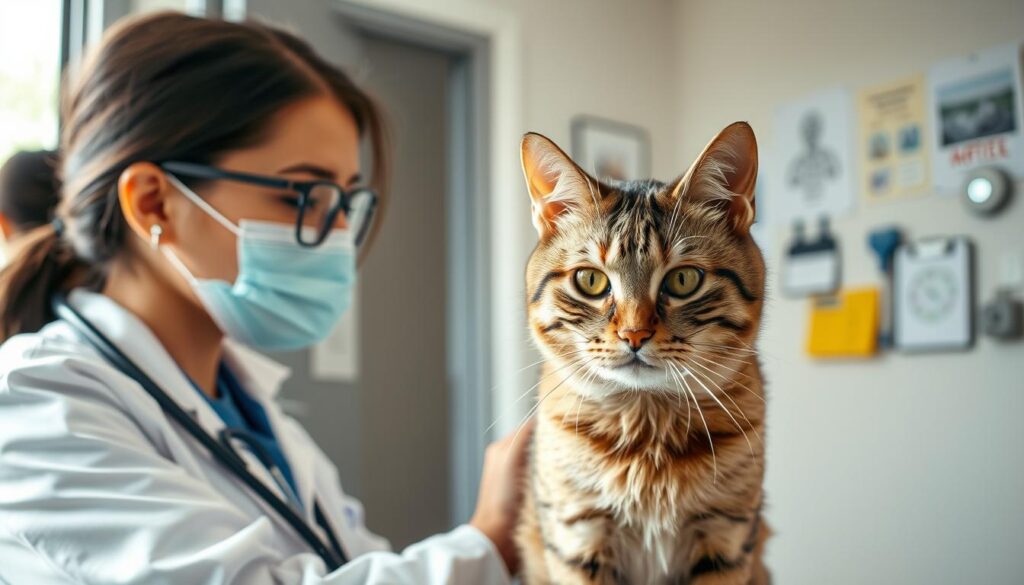Cats have now become the most common domestic animals to get rabies, surpassing dogs. In 2018, there were 241 recorded cases. It’s vital for cat owners to know the risks, how to prevent it, and the early signs of this deadly disease. Rabies attacks the brain and spreads through the saliva of infected animals, posing a big public health risk.
Rabies is rare in pet cats because of vaccination rules. But, the time it takes for symptoms to show in cats can be from three weeks to a year. Knowing the signs, how it spreads, and the need for vaccines is key to keeping your cat and family safe from this deadly virus.
Table of Contents
Understanding Rabies in Cats: A Deadly Viral Disease
Rabies is a serious and often fatal viral disease that affects the nervous system of mammals, including cats. It is caused by a virus in the Rhabdoviridae family. This virus is highly contagious and can spread between animals and even to humans through bites or contact with infected saliva.
What Makes Rabies So Dangerous
Rabies is deadly because it attacks the central nervous system. This leads to severe symptoms and death. The virus enters the body through a bite wound, then travels to the brain and spinal cord.
As it spreads, it causes inflammation and damage to the nervous system. This results in the typical signs and symptoms of rabies.
How the Virus Affects Cats
Cats are more likely to get rabies in cats than dogs because they are less vaccinated. The virus changes their behavior, causes excessive drooling, and makes swallowing hard. It also leads to seizures and paralysis.
Cat rabies symptoms can get worse fast. Once these symptoms show up, the disease is almost always fatal.
The Impact on Public Health
Rabies is a zoonotic disease, meaning it can spread from animals to humans. The CDC says there are about 5,000 animal rabies cases each year, mostly in wild animals. While human rabies is rare in the U.S., with only a few deaths a year, the risk from infected cats or other animals is still a big concern.
“Rabies, once manifested, is nearly always fatal, with the affected animal typically succumbing within a few days when signs of rabies emerge.”
It’s very important to keep up with cat rabies vaccination and prevent cat rabies symptoms. This is key to protecting pets and the community’s health.
Can Cats Get Rabies: Transmission and Risk Factors
Cats are beloved pets in many homes. But, it’s important to know that cats can get rabies. This deadly virus is a big risk for cats and people. Rabies spreads mainly through bites from sick animals or through open wounds or mucous membranes.
Outdoor cats are more at risk of getting rabies. They might meet animals like raccoons, skunks, and bats. These animals often carry the rabies virus. Cats without shots are especially at risk because they don’t have the protection they need.
The time it takes for rabies to show up in cats can vary a lot. It can be as short as 10 days or as long as a year, with most cases taking about two months. The bite’s location and severity, and how much virus is in the animal’s saliva, affect this time.
“Rabies is a disease that almost always leads to death in animals and humans once symptoms develop.”
Cat owners need to be careful to keep their pets safe. Regular rabies vaccination, keeping cats inside, and avoiding sick animals are key steps. These actions help lower the chance of cat rabies transmission and keep pets and people safe.
Common Sources of Rabies Infection in Cats
Rabies is a deadly virus that can harm both pets and wild animals. It’s important for cat owners to know where rabies comes from to protect their pets. Animals like raccoons, bats, foxes, and skunks carry the virus. They can pass it to pets, including cats and dogs that aren’t vaccinated.
Places with many stray animals are riskier because these animals can spread the virus easily. Even indoor cats can get infected if infected mice or other rodents get into the house. Things like urbanization and humans moving into wildlife areas also raise the risk for cats.
Wildlife Carriers
- Raccoons
- Bats
- Foxes
- Skunks
Domestic Animal Transmission
- Unvaccinated cats
- Unvaccinated dogs
Environmental Risk Factors
- Large populations of stray animals
- Urbanization
- Human encroachment on wildlife habitats
- Infected rodents entering the home
Knowing where rabid cats and cat rabies infection sources come from is key for pet owners. It helps them take steps to keep their cats safe from this deadly disease.
| Rabies Fact | Data |
|---|---|
| Global Human Rabies Deaths Annually | 59,000 |
| People Receiving Rabies Vaccine Annually | 29 million |
| Global Cost of Rabies per Year | US$8.6 billion |
“Rabies is a serious public health problem in over 150 countries and territories, mainly in Asia and Africa.”
The Three Stages of Rabies in Cats
Rabies is a deadly viral disease that can affect cats. It goes through three stages. Knowing these stages helps us spot the signs early and protect our cats and others.
The prodromal stage is the first phase, lasting 2-3 days. Cats may show changes in behavior, like being more affectionate or aggressive. Their pupils may also look bigger.
- Prodromal stage: Changes in temperament and behavior
- Furious stage: Restlessness, irritability, aggression, excessive salivation, and difficulty swallowing
- Paralytic stage: Coma and death
The furious stage can last 1-7 days. Cats become more restless, irritable, and aggressive. They may also drool a lot and have trouble swallowing.
The final paralytic stage lasts 2-4 days and ends in death. Cats in this stage fall into a coma and eventually die.
| Stage | Duration | Symptoms |
|---|---|---|
| Prodromal | 2-3 days | Changes in temperament and behavior, dilated pupils |
| Furious | 1-7 days | Restlessness, irritability, aggression, excessive salivation, difficulty swallowing |
| Paralytic | 2-4 days | Coma and death |
The whole feline rabies progression takes about 7-10 days. Cats usually die within 10 days of showing symptoms. Quick vet care and vaccines are key to protecting cats and preventing this disease.

Recognizing Early Warning Signs and Symptoms
Spotting the early signs of cat rabies is key to quick vet care and stopping the disease. Symptoms can differ, but knowing common changes helps owners act fast. This protects their cats and keeps everyone safe.
Behavioral Changes
In the early stages of rabies in cats, you might see small changes. They could be more irritable, anxious, or restless. Your cat might act more aggressive or lost. They might also make strange sounds or struggle with simple tasks.
Physical Symptoms
Early signs of rabies in cats also include physical signs. Look for fever, loss of appetite, and excessive drooling. These can look like other illnesses, making it vital to see a vet right away.
Progressive Disease Signs
- As rabies gets worse, cats may show severe symptoms like seizures, paralysis, and coma.
- They might also become very aggressive, attacking without reason.
- In the end, the virus can shut down the cat’s nervous system, leading to death.
Remember, these signs can mean other health problems too. A vet must check to find the real cause. Watching closely and getting vet help early is the best way to keep your cat and family safe.
Diagnosis and Veterinary Assessment
Figuring out if a cat has rabies is tough. Vets look at the cat’s shots, if it was exposed to the virus, and its symptoms. They often need to examine the cat’s brain after it dies to be sure.
If a cat might have rabies, it must be kept away from others right away. The vet will check if the cat is up to date on shots. This helps follow local rules and keep everyone safe.
| Rabies Diagnostic Techniques | Description |
|---|---|
| LN34 PCR Test | Offers exceptional sensitivity, specificity, and rapid turnaround time. Recognized as a “gold standard” by the World Health Organization (WHO) and World Organization for Animal Health (WOAH). |
| Immunohistochemistry (IHC) | More sensitive and specific than histologic staining methods like hematoxylin and eosin (H&E) for detecting rabies virus antigen in formalin-fixed tissues. |
| Rapid Fluorescent Focus Inhibition Test | Typically used to monitor antibody levels in people at risk of rabies virus exposure. |
In the U.S., test results usually come back in a day or two after an animal is put down. The CDC’s National Rabies Reference Laboratory does tests for people and animals. They need to okay the tests first.
Getting a cat’s rabies diagnosis right is key. Vets use the latest tests and follow rules to keep cats and people safe.

The Importance of Rabies Vaccination
Keeping your cat safe from rabies is very important. Rabies vaccination is often required by law and is key to cat rabies vaccination and feline rabies prevention. It protects your cat and helps keep everyone safe by stopping the spread of rabies.
Vaccination Schedule
Kittens get their first rabies shot between 12 to 16 weeks old. Then, they need a booster shot a year later. After that, they might need shots every year or every three years, depending on the vaccine and local rules.
Legal Requirements
In most US states, cats and dogs over 6 months must have rabies shots. This law shows how important it is to keep your cat’s shots up to date. Not following this can lead to serious problems.
Vaccine Effectiveness
Today’s rabies vaccines for cats work very well, with very rare side effects. The newer vaccines last three years, so you don’t need shots as often. Talking to your vet at Heart of Chelsea Veterinary Group can help make sure your cat gets the right shots.
Rabies shots are a big part of being a good pet owner. They keep your cat and your community safe. By keeping your cat’s shots current, you know they’re safe from rabies.
Treatment Options and Prognosis
When it comes to cat rabies treatment, there’s no cure once symptoms show. Rabies is almost always fatal in animals without shots. But, if a cat is vaccinated and exposed, a booster shot might help before symptoms start.
Unvaccinated cats exposed to rabies are usually put down. This is to stop their suffering and keep people safe. If you think your cat has feline rabies, tell your local health department right away. They might put your cat in quarantine to stop the virus from spreading.
“Rabies isn’t common among cats these days due to the mandatory rabies vaccine for household pets in most states.”
Rabies is more common in cats than dogs, but vaccines have helped control it. Cats usually get rabies from wild animals. The symptoms can get worse fast, depending on the bite.
Once rabies symptoms show in cats, like changes in behavior or physical signs, the outlook is bad. For unvaccinated animals, rabies is almost always fatal. It can kill within 7 to 10 days after symptoms start.
The best way to fight cat rabies is to prevent it. Keep your cat vaccinated and be a responsible pet owner. This way, you can protect your pet and your community from this deadly disease.
Preventing Rabies in Your Cat
Keeping your cat safe from rabies starts with action. The best way is regular vaccinations, which are often required by law. Keeping your cat inside also helps a lot, as they’re less likely to meet infected animals.
Indoor vs Outdoor Considerations
Indoor cats are safer from rabies, but they still need their shots. Your vet will tell you when to start and how often to get boosters. Outdoor cats need even more care, with regular vet visits to watch for rabies signs.
Protective Measures
If your cat gets bitten by an unknown animal, clean the wound and see your vet right away. Teach your family how to handle pets safely. Also, know about local rabies outbreaks and follow health advice. These steps can protect your cat and your community from rabies.

